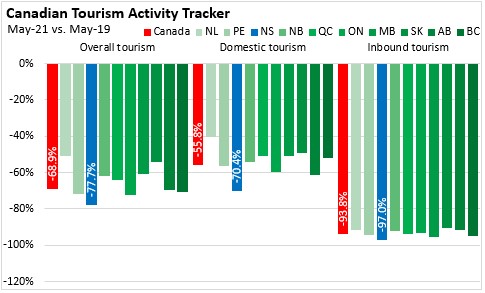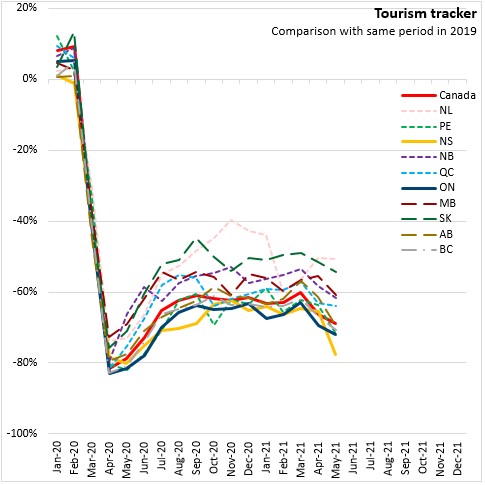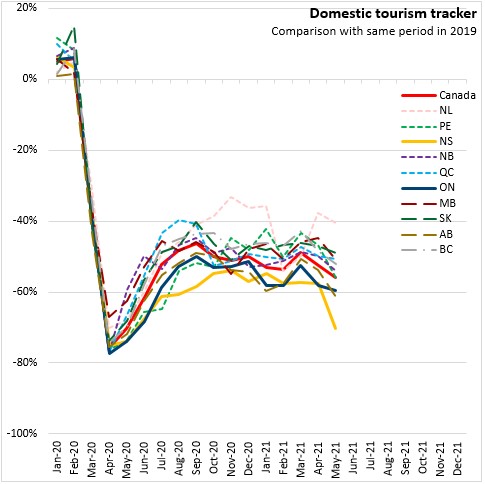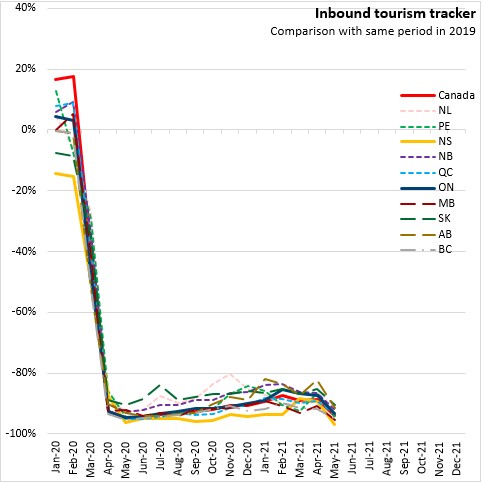The Economics and Statistics Division maintains archives of previous publications for accountability purposes, but makes no updates to keep these documents current with the latest data revisions from Statistics Canada. As a result, information in older documents may not be accurate. Please exercise caution when referring to older documents. For the latest information and historical data, please contact the individual listed to the right.
<--- Return to Archive
For additional information relating to this article, please contact:
July 29, 2021TOURISM ACTIVITY TRACKER, MAY 2021 Statistics Canada's "Canadian Tourism Activity Tracker" illustrate the impacts of the COVID-19 pandemic on tourism activity. The data reported provide a comparison between the reference period (May 2021) and the same period in 2019, prior to the pandemic. This provides a snapshot of how tourism activity has changed, including air travel, surface travel, hotels/accommodations, spending and trip duration. Tourism activity is monitored for both domestic travellers (those travelling within Canada, including within province more than 40 km from home) as well as inbound travellers from international sources. Overall tourism is estimated as a weighted average of domestic and inbound tourism activities.
At the end of April 2021, Nova Scotia implemented new travel restrictions in response to another wave of COVID-19 infections. Between May 2019 and May 2021, overall tourism activity to Nova Scotia declined by 77.7%. This was larger than the decline in tourism for any province. The national decline was 68.9%. Saskatchewan as well as Newfoundland and Labrador reported the least declines (but both still over 50%).
Between May 2019 and May 2021, Nova Scotia reported a 70.4% reduction in domestic tourism activity (which includes tourists visiting other parts of their home province). This was the largest drop among provinces. The national average decline in domestic tourism activity was 55.8%. The largest declines were in Nova Scotia and Alberta while the smallest decline was in Newfoundland and Labrador.
With international border restrictions still in place, inbound tourism from other countries has fallen sharply and remains low. Nova Scotia's inbound tourism was down 97.0% from May 2019 to May 2021. National inbound tourism was down 93.8%, with declines over 90% in every province.

Since the start of the COVID-19 pandemic, tourism activity has fallen dramatically in all provinces. For a time in the summer of 2020, Nova Scotia experienced a larger decline than in any other province. Prior to the May 2021 decline on new restrictions, Nova Scotia's tourism was in line with the national average.

In the first months of the pandemic, domestic tourism activity declined by 70-80% across most provinces. Although it has recovered somewhat since then, domestic tourism activity remains down significantly among all provinces. The decline in domestic tourism activity has been particularly acute in Nova Scotia, often reporting among the largest declines among provinces. With new restrictions in May 2021 (which included limitations on travel within the province), Nova Scotia's domestic tourism activity once again reported the largest decline among provinces.

International inbound tourism activity largely disappeared across most provinces once pandemic-related border restrictions were imposed. Although Nova Scotia reported more severe declines than other provinces in 2020, the province's inbound tourism picked up somewhat in March and April of 2021 before declining again with new restrictions in May 2021.

Source: Statistics Canada. Table 24-10-0049-01 Canadian Tourism Activity Tracker and Grouped Data Sources, Canadian Tourism Activity Tracker
<--- Return to Archive